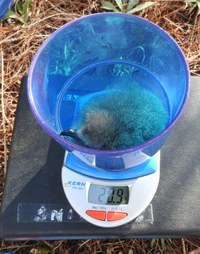Marine Ghost Hunts: Seabird Research at JLU
Located in the centre of Germany – far from any ocean – Giessen perhaps surprisingly brings together leading experts in marine biology and zoology: from involvement in the Corporation Center for Excellence in Marine Sciences (CEMarin), to a veterinary clinic treating aquatic patients and a dedicated marine holobiomics lab, to the extensive research on seabirds under the leadership of Prof. Petra Quillfeldt.

Professor Dr. Petra Quillfeldt and her research group at Justus Liebig University Giessen (JLU) study a range of seabird species and subspecies to develop a better understanding of their populations and ecology: to more clearly define the species, understand their feeding habits, and collect and analyse dynamic population data. Seabirds pose special challenges to researchers as they spend close to the entirety of the year at sea and come to shore not even to feed but only to breed. Consequently, these species are particularly vulnerable to changes in the marine ecosystem. Petra Quillfeldt and her team cooperate internationally and apply innovative methods and technologies, including GPS tracking and metabarcoding from faecal and regurgitate samples, to better understand populations and ecology and to ultimately inform and advise conservation efforts.
The Behavioural Ecology and Ecophysiology research group at JLU headed by Petra Quillfeldt studies a broad range of avian species. In addition to projects on the European turtle dove and parrots, for example, a range of projects specialises in birds inhabiting the air above pelagic zones.
Biodiversa+ Project Seaghosts
The project Seaghosts is a European research initiative focused on studying storm petrels, the two smallest seabird families (Hydrobatidae and Oceanitidae), in the Mediterranean Sea and Atlantic Ocean. From 2024 to 2027, a team of researchers from 13 countries will collaborate to investigate the ecology, breeding biology, and anthropogenic threats to these birds. Through close collaboration between Petra Quillfeldt’s team and researchers from the University of the Azores, their project branch aims to gain a better understanding of the species' behaviour, habitat, and population dynamics, as well as the impacts of human activities such as offshore wind farms and climate change.
"Storm Petrels are the smallest seabirds. Little is known about their ecology so far because GPS tracking devices have only recently become small enough to be used on these birds."
By using advanced methods like GPS tracking and DNA-Metabarcoding, the team seeks to fill knowledge gaps and produce a clearer picture of speciation, including resolving uncertainties about subspecies and potential new species. The project's findings will be used to inform conservation management and protection strategies for storm petrels, with the goal of preserving these vulnerable species by providing valuable insights for policymakers and conservationists.
DFG Priority Program Antarctic Research
In addition to the Seaghosts project, Petra Quillfeldt is involved in seabird research in the Antarctic. She is the coordinator for biological sciences of the German Research Foundation (DFG) priority program on Antarctic research and acts as the vice-president and soon-to-be president of the German National Committee for Polar Research (SCAR/IASC). As part of a long-term project started in 1995, Petra Quillfeldt studies the ecology of two storm petrel species, the Wilson’s Storm Petrel and the Black-bellied Storm Petrel, which breed in Antarctica. To produce a better understanding of the distribution, migration patterns, and diet of these species throughout the year, the project employs advanced technologies such as GPS and GLS tracking as well as analysis of DNA composition of faecal and regurgitate samples. The video below documents the fieldwork done by the international team at Carlini Base on King George Island. The collected data indicates that these birds migrate across vast distances, with some birds traveling from Antarctica to the Arctic regions of Canada, while others remain exclusively in the southern hemisphere, travelling North only up to the coast of Brazil.
Video Courtesy of the National University of Tierra del Fuego; Turn on subtitles on YouTube.
International Cooperation
Given the expansive migratory patterns of these birds, research projects and cooperations necessarily are international, with collaborations and projects spanning across multiple countries and continents. Petra Quillfeldt’s involvement in Antarctic research began during research for her diploma thesis, when she worked on an Argentine research station and learned Spanish, she recounts. This has since facilitated connections and cooperation with South American researchers. In addition to the seabird projects in the Mediterranean and the Antarctic, her research group is also involved in other projects in South America, including studies on prions, albatrosses and penguins in Chile, Mexico, and the Falkland Islands.
"Internationalisation comes with the territory when choosing to study these species."
Despite the remoteness of its objects of study, the research group based in Giessen, Germany is well-positioned to facilitate international collaborations essential for the various seabird projects. While Germany has a strong tradition of polar research with its DFG Priority Program Antarctic Research, its infrastructure is not specifically focused on seabird research. Her network established over decades of fieldwork allows Petra Quillfeldt to utilise research stations in other countries, such as Argentina and Spain, to conduct her fieldwork. Another result of these international collaborations is a tight-knit international network of experts working on blood parasites in Spain and researchers specialised in hormone analyses in Austria, for example. This international cooperation enables her projects to draw from a broader range of expertise and resources and has led to additional collaborations beyond the initial field research.
Key Findings and Conservation Efforts

The research on storm petrels done by Petra Quillfeldt and her team has highlighted significant implications for conservation. As these birds are highly pelagic and spend most of their time at sea, feeding on marine food sources such as zooplankton and small fish, they are vulnerable to various threats to the marine environment, including climate change, pollution, and habitat degradation. In the Antarctic, for example, the warming of the ocean is affecting the distribution and abundance of krill, a key food source for storm petrels, with some areas experiencing a 6–8-degree Celsius increase in winter temperatures. Other threats, such as pollution from pesticides and microplastics, as well as light pollution from coastal settlements and industrial plants, are also affecting storm petrel physiology and navigation with dramatic results on the population level.
"Since 1978, the Storm Petrel population in our Antarctic study colonies has seen a decrease of about 90%"
To address these anthropogenic threats, conservation efforts need to be tailored to the specific needs of each species, Petra Quillfeldt explains. For example, reducing light pollution from coastal settlements can be achieved through simple measures such as the targeted switching off of lights during the fledgling season, when the young birds leave for the sea. Similarly, regulating wind farms and other offshore plants seasonally can help reduce the impact on migratory species. However, addressing climate change, the root cause of the seabirds’ feeding challenges, requires a more comprehensive approach, involving international cooperation and policy changes.
The research on storm petrels is providing valuable insights into the ecology and behaviour of these birds, which can inform such conservation efforts with high resolution data. For example, GPS tracking data helps to identify key habitats and migration routes, which may inform the designation of protected areas. Additionally, the research highlights the importance of considering the complex interactions between species and their environment, including the impact of climate change on food webs and ecosystems.
"The definition of species is far from complete."
One of the key findings of the research is that some storm petrel species are not as well-defined as previously thought, with some populations exhibiting distinct differences in breeding behaviour, morphology, and genetics. For example, a population of storm petrels on the Azores was found to in fact consist of two distinct species, one breeding in the summer and the other in the winter. Similarly, the European storm petrel population is likely to be split into two distinct species, one from the Mediterranean and the other from the Atlantic. This has significant implications for conservation, as it highlights the need for more targeted and effective conservation efforts. The first publication from the Biodiversa+ project is being prepared for publication and will provide a comprehensive overview of the research findings and their implications for conservation. The research is ongoing, and future publications will provide more detailed insights into the ecology and conservation of these fascinating and elusive species.
How to get involved
If you want to learn more about the research of Prof. Petra Quillfeldt and her team or get in touch, visit the research group website.
If you are an early career researcher working on polar habitats and want to get involved, visit the homepage of the German National Committee of the Association of Polar Early Career Scientists (APECS)
Interview: Robin Schmieder, Research Campus of Central Hessen Management Office
